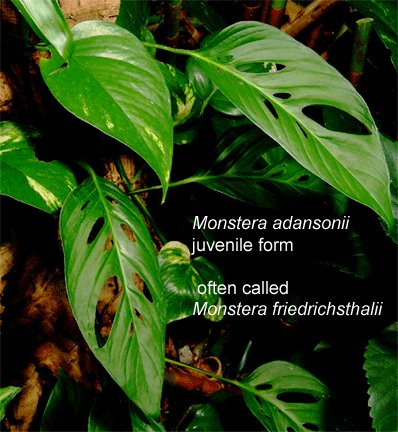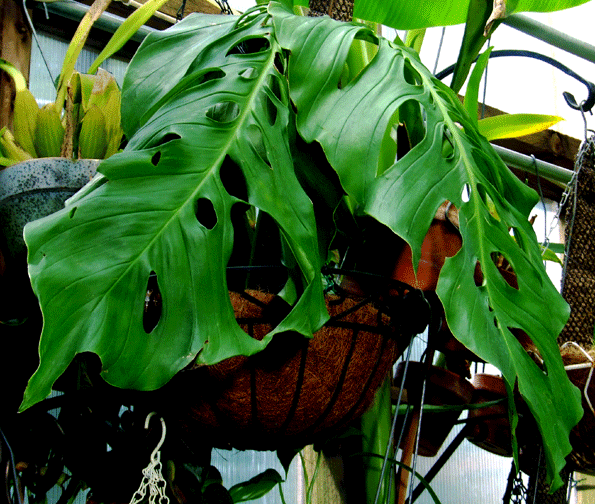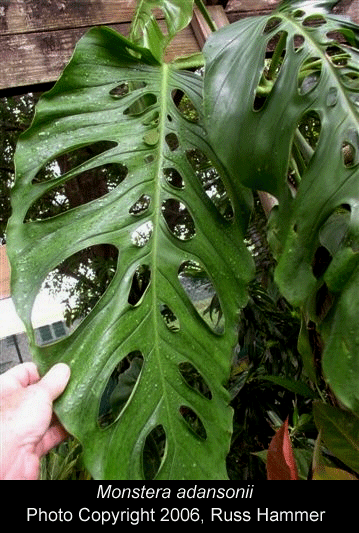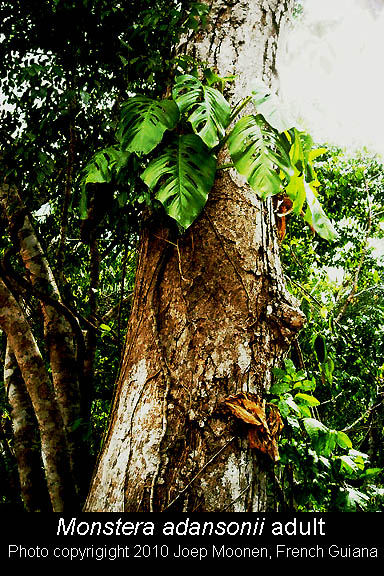![]()
Aroids and other genera in the Collection
Take the Tour Now?
Orchids
The
Exotic Rainforest
Plants in
the Exotic Rainforest Collection
The images on this website are copyright protected. Please contact us before any reuse.
|
Monstera adansonii
Schott Often known when a juvenile as Monstera friedrichsthalii Schott 
Monstera adansonii
Schott
This plant has confused botanists for close to 175 years! But please understand, each name is still scientifically accurate. But the accepted name is Monstera adansonii. The species is known to be variable and not every leaf of every plant will look exactly alike! This link will give you an easy to understand explanation of the natural variation within plant species: Click here. First described to science in 1830, Monstera adansonii, (which is a Philodendron relative, but not a Philodendron) is a good reason why I don't like common names for plants. The common name for this plant is "Swiss Cheese plant". Sound familiar? Monstera deliciosa is also commonly called the Swiss Cheese plant. And there is no telling how many other plants with fenestrations (holes in their leaves) have the same common name! The scientific term "fenestration" comes from the Latin word for "window", thus "holes". Monstera adansonii (ad-an-SON-e-eye) is the source for more than a little confusion amongst collectors.
Monstera adansonii is
a native of the Amazonian region of Peru, Ecuador and Brazil. When
small it is often sold on eBay as a Philodendron, and it is
certainly a relative, but this one is legitimately a Monstera.
M. adansonii loves to run when small, and climb when larger.
The species prefers bright filtered sunlight. Some growers insist
it should be allowed to dry between watering, we have not found that
to be necessary and water it right along with all our other
Philodendron, Monstera and Anthurium sp. at normal rain
forest rates which is basically wet, especially during the summer!
Since it is a resident of some of the wettest rain forest in South
America it would not appear to need periods of dryness.
We have grown Monstera adansonii
at more than 5 locations in the atrium plus. As a result, most of
the leaves of most of our plants have remained relatively small
because they are running rather than climbing. The blades
of our largest specimen are well over 60cm (two feet), approaching
75cm (2.5 feet). Monstera differ from Philodendron species since all Monstera produce perfect flowers containing both male and female organs while Philodendron produce imperfect flowers containing only a single sex. When an Monstera is "in flower" the reference is to the tiny flowers containing both male and female sexual parts that grow on the spadix at the center of the inflorescence. To help prevent self pollination nature has designed the female flowers to be receptive before the male portion of the flower produce their pollen so in most cases an insect must bring pollen from another plant. For more information on the sexual reproduction of any aroid click the pollination link below. The spadix attracts pollinating beetles when ready to reproduce at anthesis by producing a "perfume" known as a pheromone but is also thought by French pollination researcher Marc Gibernau to produce a visual attractant using infrared heat which the beetles can "see" with sensors that are likely on the end of their antennae. Their eyes are apparently not sensitive to the "runway" glow emitted by an aroid in the dark of the forest but the antennae can "see" this visual attractant at 20 meters (65 feet) or more. The spathe of Monstera adansonii can grow quite large (approximately 73cm or 9 inches) and is white in color while the spadix is pale green. For additional information on aroid pollination click this link.
Think of it as different faces. All humans are the same species, but we all have different body shapes and faces. That is the problem with aroids. They often look quite different, but once researched by a qualified scientist are found to be a single species. The determining factor is the inflorescence. In this case, all three of these "species" have the same inflorescence (spathe and spadix). Therefore, they are the same species. And the rules of botany give the prize to the oldest published name. So the name has not been frivolously changed, it has simply been researched and determined the first name Schott gave is the winner of the prize. That name becomes the basionym while the others become synonyms. Again, please take the time to read the discussion on natural variation within aroid species. You will be able to approach the subject with a much greater understanding of how names originate, sometimes must be replaced with the correct name as well as understanding how species are variable as well as morph: Natural variation We use extremely well drained soil with a lot of peat, Perlite, and orchid bark containing charcoal, gravel and bark mixed into the potting mixture to retain moisture. On the advice of the research greenhouse keepers at the Missouri Botanical Garden we are also now adding small pieces of long strand sphagnum moss and additional horticultural charcoal along with cypress mulch. In July 2006 Russ sent a cutting with three enormous leaves. Our large Monstera adansonii is hanging at the 12 foot level (four meters) potted in a hanging basket with a tall totem to climb. The specimen has added numerous leaves as well as many long vines which look exactly like the plant we have previously known as Monstera friedrichsthalii. with the exception of the most juvenile leaves which are simply cordate (heart shaped). As a result of the juvenile leaves collectors often believe their cutting is a Philodendron species which is incorrect.
Want to learn more about aroids?
|
 I've
had a nice little Monstera in my collection for many years
which I have known as Monstera friedrichsthalii. Plant
collecting friend Russ Hammer in Florida has a very large aroid
collection and in the summer of 2006 sent a photo of a plant I would
have sworn was Monstera friedrichsthalii. The problem was
that specimen was much larger than the 15 to 20cm (6 to 8 inch) size
I had been led to believe was the maximum blade size for M.
friedrichsthalii.
I've
had a nice little Monstera in my collection for many years
which I have known as Monstera friedrichsthalii. Plant
collecting friend Russ Hammer in Florida has a very large aroid
collection and in the summer of 2006 sent a photo of a plant I would
have sworn was Monstera friedrichsthalii. The problem was
that specimen was much larger than the 15 to 20cm (6 to 8 inch) size
I had been led to believe was the maximum blade size for M.
friedrichsthalii.  The genus Monstera is a
relatively small group of 41 scientifically recognized Neotropical
species found naturally only in Mexico, Central and South America.
There are Asian species with fenestrations (holes), but those are
members of a separate genus known as Scindapsus. As you can
see from the list of synonym names above, Monstera
adansonii has also been known by quite a few scientific names,
and many of those names were given by one botanist. That occurred
due to the unique fact this species is extremely variable and morphs
as it grows. Very simply, it changes in appearance!
The genus Monstera is a
relatively small group of 41 scientifically recognized Neotropical
species found naturally only in Mexico, Central and South America.
There are Asian species with fenestrations (holes), but those are
members of a separate genus known as Scindapsus. As you can
see from the list of synonym names above, Monstera
adansonii has also been known by quite a few scientific names,
and many of those names were given by one botanist. That occurred
due to the unique fact this species is extremely variable and morphs
as it grows. Very simply, it changes in appearance! 

 One internet discussion group seems
to be quite disturbed with botanists who have "changed the name" of
this species. Perhaps a bit of explanation is deserved. In 1830
botanist Schott went into the field and found a plant which he named
Monstera adansonii. And again in 1854 Schott went back into
the field and found a plant he felt was different and named it
Monstera
One internet discussion group seems
to be quite disturbed with botanists who have "changed the name" of
this species. Perhaps a bit of explanation is deserved. In 1830
botanist Schott went into the field and found a plant which he named
Monstera adansonii. And again in 1854 Schott went back into
the field and found a plant he felt was different and named it
Monstera 